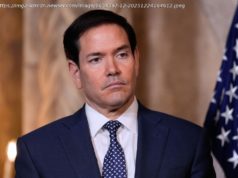Saturday’s march against family separation grew into a much broader appeal for moral high ground.
WASHINGTON, D. C. — The pathway of protest is well known to those who choose to walk it. Often starting with gatherings in Lafayette Square, where rallies can rattle the windows of the adjacent White House, people stream onto Pennsylvania Avenue, heading to go make a human wreathe around the Department of Justice and other government buildings. Over the past year, the pathway has become well worn, the sight of thousands of footprints on the grass in the city’s squares or the National Mall much more commonplace. The chants are often similar. On Saturday, when some 50,000 protesters descended upon the nation’s capital, they hewed close to what’s now become a D. C. leitmotif.
But it was there in Lafayette Square, under the statue of the Marquis de Lafayette, one of the most important foreign-born citizens in American history, where this protest blended the old and the new, and showcased what the next few years of politics will look like. There, at a rally originally created to protest the Trump administration’s policy of stripping immigrant children from families at the border, demonstrators protested several related issues and joined in spirit with the hundreds of other rallies that were held around the country.
At this rally, the luminaries were there in their full brightness. Lin-Manuel Miranda, America Ferrera, Alicia Keys and other celebrities gave emotional speeches, demanding an end to this administration’s immigration policy, and providing a family-centered view of the ultimate effects of that policy. Of those, the most personal speech came from Orange is The New Black star Diane Guerrero, an American-born daughter of Colombian parents who at 14 was separated from them when her parents were deported. “Even some 17 years later, I can still remember how it felt when I first cried out for my parents and they couldn’t answer,” Guerrero told the crowd.
But it was the testimonials and calls to action from lesser-known people on stage that brought the strongest emotional charge to the event. A 12-year-old girl who identified herself only as Leah described her life as the daughter of an undocumented woman who works as a domestic caretaker. She tearfully recounted her story and the constant fear of losing her mother, tying it to the fear and disruption young children must experience when separated from parents at the border. Other powerful firsthand accounts from people affected by immigration policies reverberated from the small stage at the eastern edge of the square. A youth choir roused the crowd into a marching mood with a taut rendition of Michael Jackson’s “Man in the Mirror.”
One thing about this rally that immediately stood out is that it expanded considerably on its original stated mandate, as noted in its name, Families Belong Together. That expansion reflected the desperate state of the week for people to the left of the White House. This week, the Supreme Court alone took a wrecking ball to some cornerstones of American progressive policy, dealing a big blow to labor, approving Trump’s anti-Muslim travel ban, and setting the stage for the end of Roe v. Wade —among other things —with the retirement of Justice Anthony Kennedy. Speakers and signs decried each of these developments, and also set their sights on broader racial and gender injustices and mass incarceration.
There was a sense that after one of the worst single weeks for progressive policy in decades, the rally in Washington and the sister marches in hundreds of events across the country were both cathartic for their liberal participants and deliberate attempts to find a way forward. The event in D. C. built on organizing infrastructure laid by two massive women’s marches and smaller events, but it advanced a synthesized policy agenda that added to the concerns that animated the early resistance.
The event leaned heavily on the language of morals, safety, and family. This, of course, serves to rebuke the common conservative critique of liberal policies as a vast plot to undermine families and safety. The shift in focus at many of these rallies has attempted to move the moral high ground and public opinion away from Trump’s policy agenda, and away from the party that has for decades branded itself as the party for families.
That approach, a staple of civil-rights organizing, has been newly emphasized by movements such as the Moral Movement and t he Poor People’s Campaign led by Rev. William Barber, and is purposefully tailored for the time. The ongoing bet from the White House appears to be that enough American voters may not oppose policies that are tough on Central American asylum-seekers or Syrian refugees. But given the success of events like these and the bipartisan outrage over family separation, the Trump administration should be worried.
As mothers and daughters took the stage holding hands together, as strollers flattened the grass, as interpreters translated English to Spanish and to sign language, and as the closing chorus of Jackson’s song echoed back and forth from the stage, the meaning of the rally and the march came sharply into focus: Families matter, and families are fighting. No message could have been any clearer.






